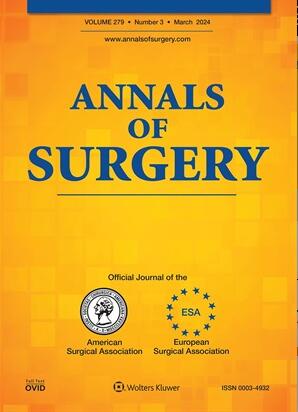The Death of Laparoscopy - Volume 2: A Revised Prognosis. A retrospective study.
IF 6.4
1区 医学
Q1 SURGERY
引用次数: 0
Abstract
OBJECTIVE To assess trends in surgical approaches (robotic, laparoscopic, and open) for various procedures, including prostatectomy, nephrectomy, cystectomy, colectomy, proctectomy, pancreatectomy, hepatectomy, and esophagectomy, and predict the future of these surgical approaches. SUMMARY BACKGROUND DATA The rapid adoption of robotic surgery has raised critical questions about the future of traditional laparoscopic techniques. Understanding the trends and potential dominance of robotic surgery is essential for surgical training, healthcare infrastructure, and resource allocation. METHODS This retrospective observational study utilized data from the American College of Surgeons National Surgical Quality Improvement Program (ACS-NSQIP) from 2012 to 2023. Vector Autoregressive modeling analyzed trends and predicted future patterns for robotic, laparoscopic, or open surgical approaches across the specified procedures. The study included all reported cases in the database where the surgical approach was specified. RESULTS The analysis revealed a continued shift towards robotic surgery, particularly dominant in urologic procedures and rapidly adopted for complex operations like hepatectomy and esophagectomy. Laparoscopy's use is declining across most specialties, though it remains significant in colectomy. Open surgery persists at high rates, especially in pancreatic and rectal operations. Projections suggest robotic surgery will surpass laparoscopy in colectomy (44.5%) and proctectomy (38.3%) by 2026. CONCLUSIONS The transition toward robotic surgery continues across specialties at varying rates. These findings have significant implications for surgical training, healthcare infrastructure, and resource allocation. The high rates of open surgery in certain procedures highlight opportunities for broader adoption of minimally invasive techniques.腹腔镜死亡-第2卷:修订后的预后。回顾性研究。
目的评估各种手术入路(机器人、腹腔镜和开放式)的趋势,包括前列腺切除术、肾切除术、膀胱切除术、结肠切除术、直肠切除术、胰腺切除术、肝切除术和食管切除术,并预测这些手术入路的未来。摘要背景数据机器人手术的快速采用对传统腹腔镜技术的未来提出了关键问题。了解机器人手术的趋势和潜在优势对外科培训、医疗基础设施和资源分配至关重要。方法本回顾性观察性研究采用2012 - 2023年美国外科医师学会国家手术质量改进计划(ACS-NSQIP)的数据。向量自回归模型分析趋势,并预测未来的模式,机器人,腹腔镜手术,或开放手术途径在特定的程序。该研究包括数据库中指定手术入路的所有报告病例。结果分析显示,机器人手术在泌尿外科手术中占主导地位,并迅速应用于复杂的手术,如肝切除术和食管切除术。腹腔镜的使用在大多数专科都在下降,尽管它在结肠切除术中仍然很重要。开放手术的比率仍然很高,特别是在胰腺和直肠手术中。预测显示,到2026年,机器人手术在结肠切除术(44.5%)和直肠切除术(38.3%)方面将超过腹腔镜手术。向机器人手术的过渡在不同的专科继续以不同的速度进行。这些发现对外科培训、医疗基础设施和资源分配具有重要意义。开放手术在某些程序中的高比率突出了广泛采用微创技术的机会。
本文章由计算机程序翻译,如有差异,请以英文原文为准。
求助全文
约1分钟内获得全文
求助全文
来源期刊

Annals of surgery
医学-外科
CiteScore
14.40
自引率
4.40%
发文量
687
审稿时长
4 months
期刊介绍:
The Annals of Surgery is a renowned surgery journal, recognized globally for its extensive scholarly references. It serves as a valuable resource for the international medical community by disseminating knowledge regarding important developments in surgical science and practice. Surgeons regularly turn to the Annals of Surgery to stay updated on innovative practices and techniques. The journal also offers special editorial features such as "Advances in Surgical Technique," offering timely coverage of ongoing clinical issues. Additionally, the journal publishes monthly review articles that address the latest concerns in surgical practice.
 求助内容:
求助内容: 应助结果提醒方式:
应助结果提醒方式:


